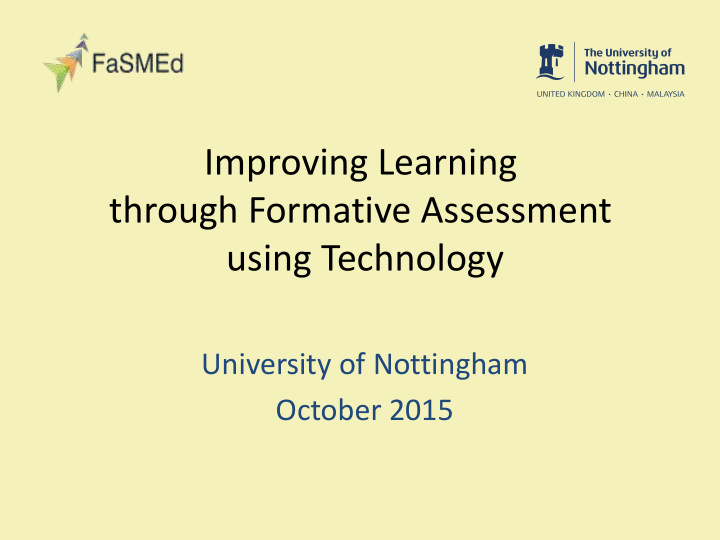



Improving Learning through Formative Assessment using Technology University of Nottingham October 2015
The FaSMeD project The research focuses on the use of iPads in mathematics lessons and how they can be used to facilitate or enhance formative assessment. The lessons in this phase all involved some use iPads (or laptops) but with different software and mathematical topics.
Research questions How do teachers process or present formative assessment data from students using a range of technologies? How do teachers inform their future teaching using such data?
Formative assessment What is the impact from using the technology when: • Building on student’s prior knowledge; • Identifying and responding to students’ conceptual difficulties; • Using questioning; • Increasing student collaboration; • Enabling students to become assessors?
Lesson 1: distance-time graphs • Two diagnostic questions to start the lesson; • Use of Showbie to send, receive and display selected student responses; • Selected student work used to discuss and address misconceptions; • Peer assessment and discussion based on responses to ‘mirrored’ questions.
Interpreting a graph A walk to the shop... One day John went for a walk to the shop. The graph shows his walk. Describe what may have happened.
Drawing a graph A long drive home Sarah left her friend’s house at 5pm. Her drive home was expected to be 140km. She travelled at a constant speed of 80km/h for 30 minutes. She was then stuck in a stationary traffic jam for 10 minutes. The traffic then began moving at a constant speed of 60km/h for 20 minutes. Finally, the traffic cleared and she completed her journey home at a constant speed of 120km/h. Complete the graph for Sarah’s journey.
Discussion and decisions
Completing and sharing
Mirrored questions Set A Set B
Peer assessment and discussion
Lesson 2: algebraic expressions • Diagnostic assessment prior to lesson using diagnosticquestions.com; • Lesson plan adapted in response to the profile of student responses and reasons given; • Use of Nearpod to send, receive and display selected student responses; • Selected student work used to discuss and address misconceptions.
Pre-lesson diagnostic questions https://www.diagnosticquestions.com
Selection of questions by teacher
Choices for student
Student response
Options for student
Teacher overview
Class profiles
Questions for students Write down an expression for the area of this shape … n 3 2
Class discussion
Lesson 3: Tessellation • Students discuss common shapes and their properties with the teacher; • Students make predictions of shapes that will tessellate; • Students use the “Tessellation creator” app to test their predictions; • Students explore tessellations of two or more shapes; • Students view, assess and comment on work by their peers.
Discussing tessellation
Making predictions
Testing the predictions
Exploring further
Peer assessment
The role of technology (1) A direct replacement for paper-based methods of formative assessment?
The role of technology (2) A replacement with the same function but additional benefits? Less time drawing so more time for Ease and speed student discussion of obtaining class profiles Easy access to Easy access to student work for student work in class discussion progress
The role of technology (3) A replacement with the same function but some disadvantages? Discontinuity for the individual Lack of permanence Visibility of personal Lack of accuracy mistakes. in drawing? Copying responses.
The role of technology (4) A tool that significantly changes the process of formative assessment? Presenting new questions and areas for exploration? Changing the nature of peer assessment and discussion?
Functionality of technology in formative assessment • Sending and sharing • Processing and analysing • Providing an interactive environment
ASK ANSWER ANALYSE ADAPT Elicit information by Respond orally, in Interpret response, Modify teaching questioning or writing or via offer and interpret and learning observing. technology. feedback. Interpretation and Teacher Teacher adapts feedback asks question or provided question lesson by teacher Interpretation Student Student Peer Student and feedback modi fie s interprets asks responds to provided response to feedback question question by peer question Processing and Technology Technology feedback adapts question asks provided by question technology
Recommend
More recommend